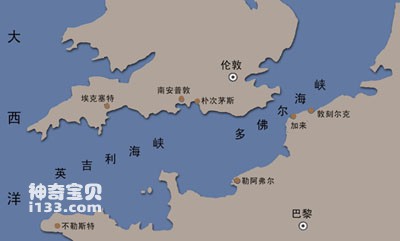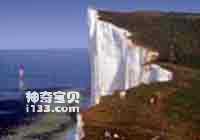Between the island of Great Britain and the European continent, there is a waterway connecting the Atlantic Ocean and the North Sea, which is the famous English Channel and the Strait of Dover. These two straits are actually one, but historically they have been divided into two straits, bounded by the mouth of the Seine in France to Portsmouth in the United Kingdom. The southwest section is the English Channel, and the northeast section is the Strait of Dover. The total length is about 600 kilometers, the widest point is 220 kilometers, and the narrowest point is only 33 kilometers from Dover, England to Cape Gray, west of Calais, France. It covers an area of about 90,000 square kilometers.

Diagram of the English Channel and the Strait of Dover
The island of Great Britain and the European continent were originally connected together. Later, affected by the Alpine orogeny, folds and fractures occurred near the strait. Since then, the strait area has continued to sink, and seawater has entered the strait, separating the British Isles from the European continent and becoming the current strait. The bottom of the channel is mainly gravel and rock. The southwest opening of the strait is wide and trumpet-shaped. The tidal energy drawn from the Atlantic Ocean quickly concentrates. The strong current causes huge waves up to 6 meters high, and also creates a huge tidal range. The tidal range in France's Saint-Malo Bay and Somme Estuary can reach 12 meters. The maximum tidal range at the mouth of the Langs River is as high as 13.5 meters, and the Langs Power Station, the world's largest tidal power station, is built here. Powerful currents and huge waves crash and wash against the shore walls, causing rocks to collapse and the coast to recede. According to statistics, the width of the strait increases by more than 1 meter every year.
Affected by the warm North Atlantic current and westerly winds, the Strait has a climate that is warm in winter and cool in summer. It is humid, rainy and foggy all year round, with few sunny days. The French coast here has about 200 rainy days every year, with a rainfall of more than 800 millimeters; the British coast is blocked by mountains, and it rains more than 150 days every year. As the cold air from the north meets the warm ocean surface, it is foggy all year round, with the foggy season lasting for more than 6 months.

The White Cliffs of Dover, England
The Strait is rich in resources, rich in herring, herring, and flounder. Mineral deposits include oil and natural gas. Ocean tidal energy is about 80 million kilowatts, accounting for about 5% of the world's total tidal energy. The Lens tidal power station in France, built in 1966, has an annual power generation capacity of 544 million kilowatt-hours and is currently the largest tidal power station in the world.
The English Channel and the Strait of Dover are the only routes from Europe to America and Africa. Historically, it has played a major role in the economic development of European capitalist countries and is commonly known as the "Silver Channel." Both sides of the Taiwan Strait are densely covered with ports and have developed industries. Plymouth, Annampton, and Dover in the United Kingdom; Cherbourg, Le Havre, Calais, and Dunkirk in France are all famous ports and industrial cities. The English Channel and the Strait of Dover are the busiest waterways for international shipping. There are 120,000 ships passing through the strait every year, ranking first among all straits in the world. For a long time, travel between the UK and the European continent has mainly relied on cross-strait ferries, which are criss-crossed by shipping and are very congested and inconvenient. As early as 1802, French engineer Mathieu suggested to Napoleon to dig an undersea tunnel in the Strait of Dover. After that, many people brought it up again, but they never came to fruition. In recent years, more and more people have passed through the Strait. After the United Kingdom joined the European Community in 1973, the traffic became even busier. There are more than 5 million ferry passengers and more than 1 million vehicles every year. In July 1973, Britain and France reached an agreement to jointly dig an undersea tunnel in the Strait of Dover. Construction of this European undersea tunnel started in 1987 and was fully opened on June 28, 1991. The project cost US$17 billion. During the four-year construction, 6 British and 2 French people died for the construction of the tunnel. The tunnel is 53 kilometers long and consists of a central service tunnel and two railway tunnels in the north and south. It starts from Shakespeare's Cliff in England in the west, passes through a depth of 62 meters under the sea, and extends to Sangat in France. After the tunnel was put into operation, the time from the UK to the European continent was greatly shortened. A high-speed train runs back and forth every ten minutes, and it only takes 35 minutes to cross the Channel.
animal tags:
We created this article in conjunction with AI technology, then made sure it was fact-checked and edited by a Animals Top editor.